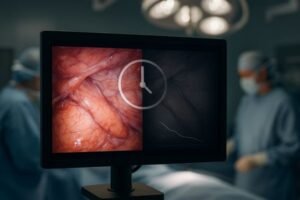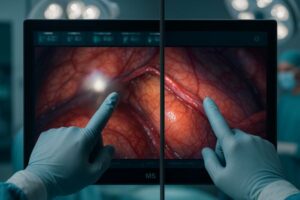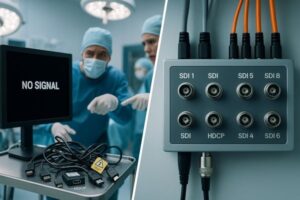Poor visualization during minimally invasive surgery can compromise safety and precision. This uncertainty increases risks when navigating delicate anatomy. Modern medical displays provide the clarity and detail needed for surgical confidence.
High-resolution displays, accurate color, and other key features directly improve outcomes in minimally invasive surgery. This guide covers visualization, teamwork, data integration, and infection control across key applications.
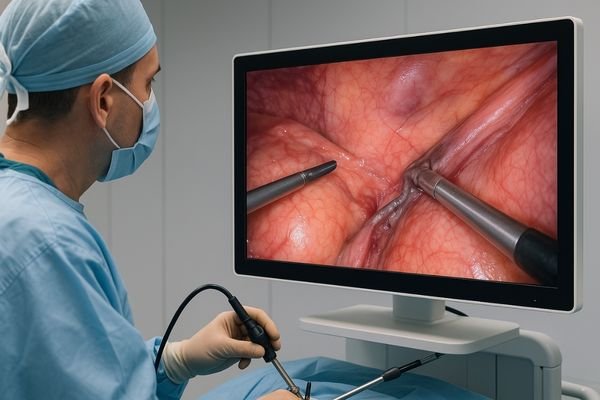
The medical display is the surgeon’s window into the patient’s body during a minimally invasive procedure1. Its quality is not a matter of preference; it is a fundamental component of the surgical system that directly influences every decision and movement. As surgery becomes more technologically advanced, the role of the display becomes even more critical, enhancing surgical performance2 and contributing to better patient care. Selecting the right display is a crucial step in equipping any modern operating room.
High-resolution displays enhance visualization of fine anatomical structures in minimally invasive procedures
Surgeons can struggle to see fine details with standard-definition displays. This ambiguity can lead to procedural errors and serious complications. High-resolution medical displays reveal critical anatomical structures with exceptional clarity.
High-resolution displays are essential for navigating complex anatomical pathways in minimally invasive surgery. This enhanced detail allows surgeons to operate with greater confidence and precision, directly improving patient safety and outcomes.
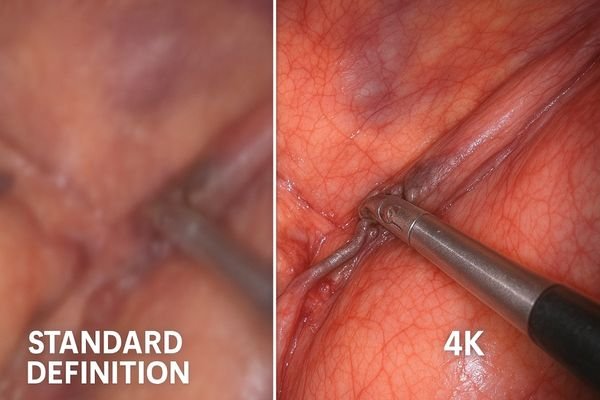
In minimally invasive surgery, the display is the surgeon’s eyes. The ability to distinguish between tiny nerves, blood vessels, and tissue planes is paramount. High-resolution monitors, particularly those with 4K capabilities3, provide the pixel density required to render these fine structures with incredible detail. This is not just a marginal improvement; it fundamentally changes the surgeon’s ability to operate with confidence. In procedures like neurosurgery or complex laparoscopic resections, a higher resolution means the difference between confidently dissecting a tumor margin and hesitating due to an unclear image. This clarity reduces surgical time and minimizes the risk of inadvertently damaging delicate tissues. Minimally invasive surgery relies completely on the quality of the visual information presented. Therefore, investing in a high-resolution display like the MS275P is a direct investment in surgical precision and patient safety.
Accurate color reproduction supports differentiation of tissues during endoscopic surgery
Inaccurate colors on a display can obscure the differences between healthy and pathological tissue. This confusion makes it difficult to make critical, time-sensitive decisions during surgery. Medical displays with precise color reproduction ensure surgeons can clearly identify tissue types.
Accurate color is not an aesthetic feature; it is a critical diagnostic tool. It enables surgeons to reliably differentiate between tissue types, identify blood vessels, and assess tissue viability, which is essential for successful surgery.
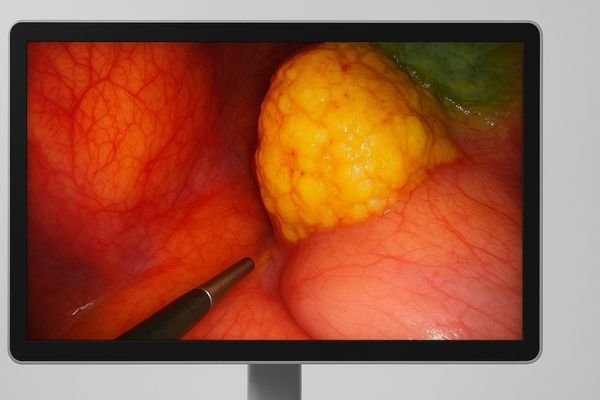
Color fidelity4 is a crucial functional requirement for surgical displays. The human eye uses subtle variations in color to identify different biological structures. A medical display must faithfully reproduce these colors to be effective. For example, the ability to distinguish the slightly different red of an artery from that of a vein, or to identify the pale, subtle discoloration of ischemic tissue, is critical. This impacts surgical decision-making in real time. During gallbladder removal, accurate color helps surgeons identify the cystic duct and artery, avoiding injury to the common bile duct. In cancer surgery, color can help define the tumor margins. Manufacturers achieve this through wide color gamuts5 and precise factory calibration. A display like the MS321PB, which supports advanced color standards, ensures that the image the surgeon sees is a true representation of the anatomy, enabling safer and more effective procedures.
Role of Color in Surgical Tissue Identification
| Tissue / Structure | Key Color Indicators | Surgical Implication |
|---|---|---|
| Arterial Vessel | Bright Red (Oxygenated) | Must be identified and controlled to prevent major bleeding. |
| Venous Vessel | Dark Red / Bluish | Requires careful handling to avoid bleeding and air embolism. |
| Nerve Tissue | Pearly White / Pale Yellow | Must be preserved to maintain function; injury can be catastrophic. |
| Ischemic Tissue | Dusky, Bluish, or Grey | Indicates lack of blood flow; may need to be resected. |
| Fatty Tissue | Yellow | Serves as a landmark and must be dissected to reach target organs. |
Wide viewing angles and consistent brightness improve teamwork in surgical environments
The entire surgical team needs a clear, consistent view, but standard monitors have limited viewing angles. This forces team members to crowd the display or work with a distorted, unreliable image. Displays with wide viewing angles provide a consistent image for everyone.
Surgery is a team effort. Wide viewing angles ensure that every team member, from the lead surgeon to the assisting nurse, sees the same high-quality image without color shift or brightness loss, fostering better collaboration.
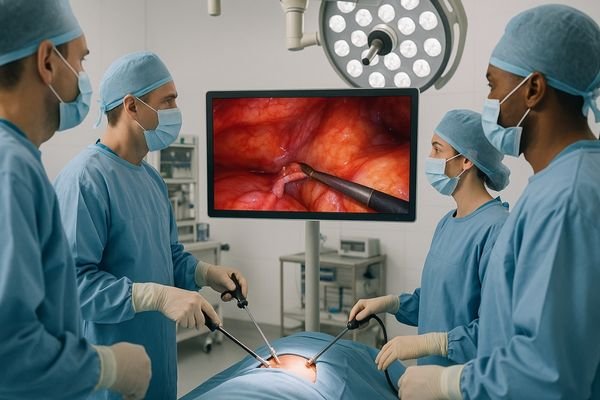
Modern surgery is a highly collaborative process. The surgeon, assistants, nurses, and anesthesiologist all rely on the information presented on the surgical display6 to anticipate next steps and work in unison. A display with poor viewing angles undermines this teamwork. If a nurse standing to the side sees a different color or a dimmer image than the surgeon, their ability to assist effectively is compromised. This can lead to miscommunication and delays. High-quality medical displays use panel technology, such as In-Plane Switching (IPS)7, that maintains color and brightness consistency even at off-axis angles up to 178 degrees. This ensures that every person in the room has the same clear, accurate view of the surgical field. Large-format displays like the MS430PC are especially beneficial in teaching hospitals and complex cases, as they create a common visual reference point that enhances communication, efficiency, and safety for the entire team.
Real-time multi-window display facilitates simultaneous monitoring of imaging and patient data
During complex procedures, surgeons need to see multiple sources of information at once. Constantly switching views or looking at different monitors is distracting and highly inefficient. Multi-window displays integrate all necessary information onto a single, cohesive screen.
Modern surgeries require integrating various data streams. Multi-window functionality allows surgeons to view live endoscopic video, vitals, and radiological images simultaneously, improving situational awareness and workflow.
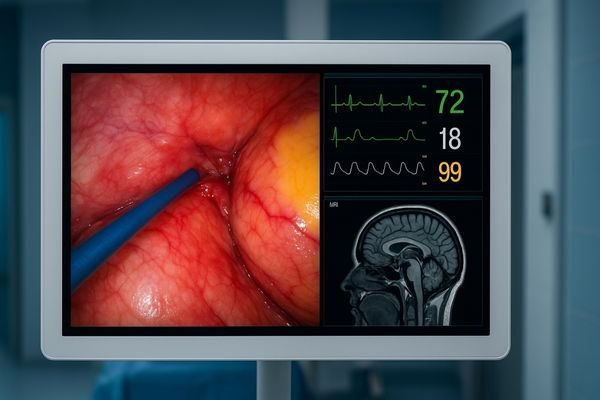
A surgeon’s attention is their most valuable resource. Multi-window display functions like Picture-in-Picture (PiP)8 and Picture-by-Picture (PbP) are designed to preserve it. Instead of dedicating separate monitors for the endoscopic camera, vital signs, and pre-operative scans, all this information can be consolidated onto one large screen. For example, a thoracic surgeon can view a live thoracoscopic feed alongside a pre-operative CT scan to precisely locate a lung nodule. A neurosurgeon can monitor a live microscopic view while keeping an eye on brain activity monitoring data. This simultaneous visualization provides critical context, reduces the need for the surgeon to turn their head, and minimizes mental strain. It streamlines the workflow and allows for more informed, real-time decision-making. A large display9 like the MS550P excels in this role, providing ample screen real estate to manage multiple high-resolution video and data feeds without compromise.
Common Multi-Window Configurations in Surgery
| Configuration Mode | Primary View | Secondary View(s) | Typical Application |
|---|---|---|---|
| Picture-in-Picture (PiP) | Live Endoscopic Feed | Patient Vitals (ECG, SpO2) | General Laparoscopy |
| Picture-by-Picture (PbP) | Live Endoscopic Feed | Pre-operative MRI/CT Scan | Neurosurgery, Tumor Resection |
| Picture-by-Picture (PbP) | Live Surgical View | Live Ultrasound Feed | Hepatobiliary Surgery, Biopsies |
| Quad-View | Multiple Camera Angles | Patient Data, Fluoroscopy | Hybrid OR, Complex Trauma |
Durability and cleanability of medical displays ensure compliance with infection control protocols
Operating rooms have strict hygiene requirements that standard consumer electronics cannot possibly meet. Using non-compliant equipment introduces a serious risk of hospital-acquired infections. Medical displays are engineered with durable, easily sanitized surfaces to meet strict OR cleaning protocols.
Infection control is non-negotiable in the operating room. Medical-grade displays feature seamless front panels, IP ratings for fluid resistance, and materials that withstand harsh chemical disinfectants, ensuring patient safety and regulatory compliance.
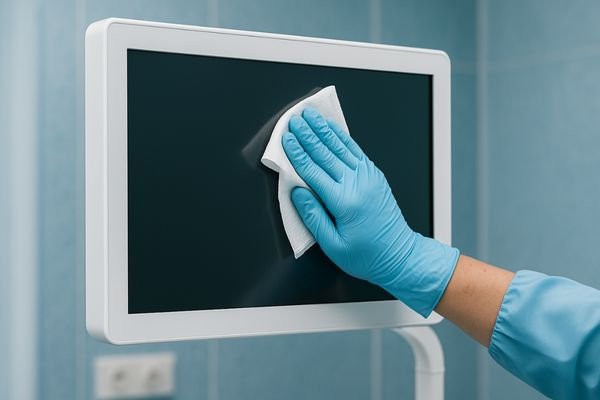
A medical display is a potential vector for pathogens if not designed correctly. That is why they are built to a much higher standard than consumer-grade monitors. The design prioritizes cleanability and durability. One key feature is a seamless, edge-to-edge front glass panel. This eliminates crevices or button gaps where blood, bodily fluids, and microbes can accumulate. The housing is often made of materials that can withstand repeated cleaning with the harsh chemical disinfectants used in hospitals without degrading. Furthermore, many surgical displays feature a high IP (Ingress Protection) rating10 on the front surface, certifying their resistance to dust and liquid splashes. Some models also use fanless cooling designs11 to prevent the circulation of airborne contaminants within the sterile field. These design choices are not optional; they are essential for preventing surgical site infections and ensuring the hospital complies with hygiene regulations. Displays like the MS321PC are built with these principles at their core.
Integration with surgical navigation and robotic systems expands capabilities of minimally invasive operations
Advanced robotic and navigation systems generate complex visual data that requires a specialized display. A standard monitor cannot handle the low-latency and high-resolution demands of these sophisticated surgical systems. Medical displays are designed to integrate seamlessly, unlocking their full potential.
Medical displays are the visual centerpiece of the modern integrated OR. Seamless integration with robotic platforms and navigation systems is essential for enhancing surgical precision and enabling next-generation procedures.
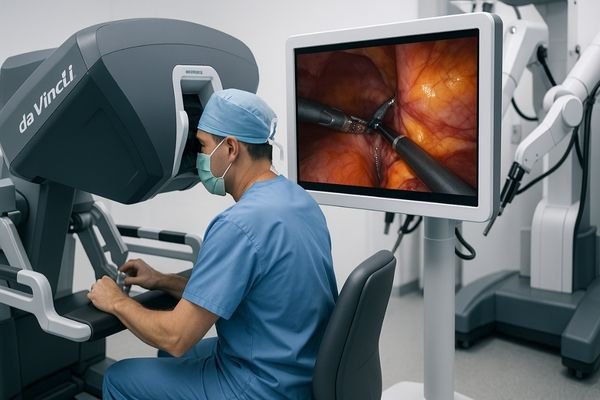
The medical display acts as the critical bridge between the surgeon and advanced surgical tools. For robotic surgery, near-zero latency is essential for the surgeon’s hand movements to translate into immediate and precise actions by the robot. Any perceptible delay would make intricate maneuvers impossible. Similarly, surgical navigation systems that overlay pre-operative CT or MRI scans onto the live camera feed require a display that can flawlessly render both layers of information. This is where augmented reality (AR) in the OR12 comes to life. The display must have the processing power and specialized inputs to handle these complex data streams without flicker, lag, or distortion. As these technologies become standard, the display’s role evolves from a simple screen to a sophisticated command and control interface. A versatile monitor like the MS270P provides the reliable performance and connectivity options needed to support integration with a wide range of third-party OR systems.
Brands like Reshin provide specialized solutions tailored for endoscopic and laparoscopic procedures
Generic displays often fail to meet the specific and demanding requirements of endoscopic surgery. This forces surgeons to work with compromised image quality under challenging visual conditions. Specialized manufacturers like us develop displays specifically designed for the nuances of minimally invasive surgery.
We develop displays to overcome the unique challenges of minimally invasive surgery. Our portfolio offers high brightness and contrast to compensate for low-light conditions and complex viewing angles, ensuring optimal visualization.
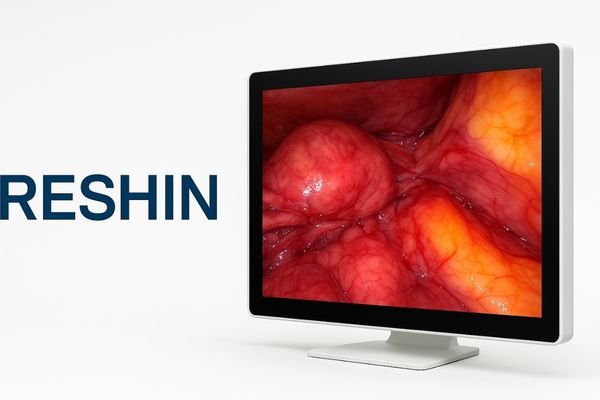
Understanding the clinical environment is key to designing a useful product. Endoscopic surgery presents unique visual challenges. The light source is internal and often weak, requiring a display with very high brightness to produce a clear image. Specular reflections from wet tissue surfaces can create glare, which needs to be managed through advanced anti-glare coatings and image processing. The camera’s narrow field of view means the surgeon needs a display with high contrast to perceive depth and detail within a limited area. We have engineered our products to address these specific problems. By focusing on the unique demands of minimally invasive procedures13, we provide solutions that perform reliably in the real-world operating room. Our intimate knowledge of the surgical workflow allows us to build displays, such as the MS247SA, that are not just technically proficient but clinically effective, directly supporting the surgeon’s ability to perform at their best.
Conclusion
Medical displays are fundamental to modern minimally invasive surgery. Critical features like high resolution, accurate color, team visibility, and system integration directly improve patient outcomes, enhance safety, and boost surgical efficiency.
📩 Want to upgrade your minimally invasive surgery setup with advanced medical displays? Contact Martin at martin@reshinmonitors.com for expert solutions from Reshin.
-
Explore this link to understand how minimally invasive procedures enhance patient recovery and surgical outcomes. ↩
-
Discover insights on how advanced display technology can significantly improve surgical precision and efficiency. ↩
-
Discover the advantages of 4K capabilities in surgical displays and their impact on surgical performance and safety. ↩
-
Understanding color fidelity is essential for ensuring accurate surgical displays, which can significantly impact patient outcomes. ↩
-
Exploring wide color gamuts can reveal how they enhance image quality in surgical displays, crucial for precise medical procedures. ↩
-
Discover the importance of surgical displays in facilitating clear communication among surgical teams, ensuring better outcomes and safety. ↩
-
Explore this link to understand how IPS technology enhances color accuracy and viewing angles in medical displays, crucial for surgical teamwork. ↩
-
Explore how PiP technology enhances surgical efficiency and decision-making by allowing simultaneous viewing of critical data. ↩
-
Learn about the advantages of large displays in surgery, including improved visualization and reduced mental strain for surgeons. ↩
-
Understanding IP ratings helps ensure the safety and hygiene of medical displays, crucial for preventing infections. ↩
-
Exploring fanless cooling designs reveals how they enhance sterile environments by minimizing airborne contaminants. ↩
-
Exploring this resource will provide insights into how AR enhances surgical precision and efficiency. ↩
-
Discover the advantages of minimally invasive procedures, which can lead to better patient outcomes and faster recovery times. ↩

